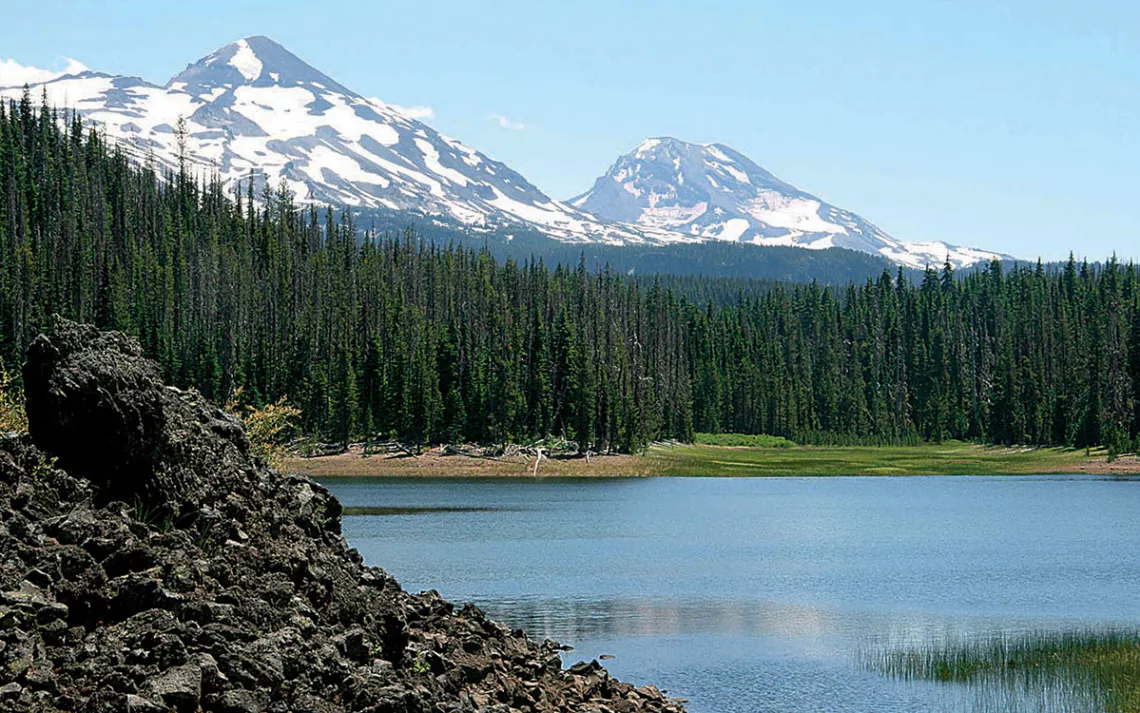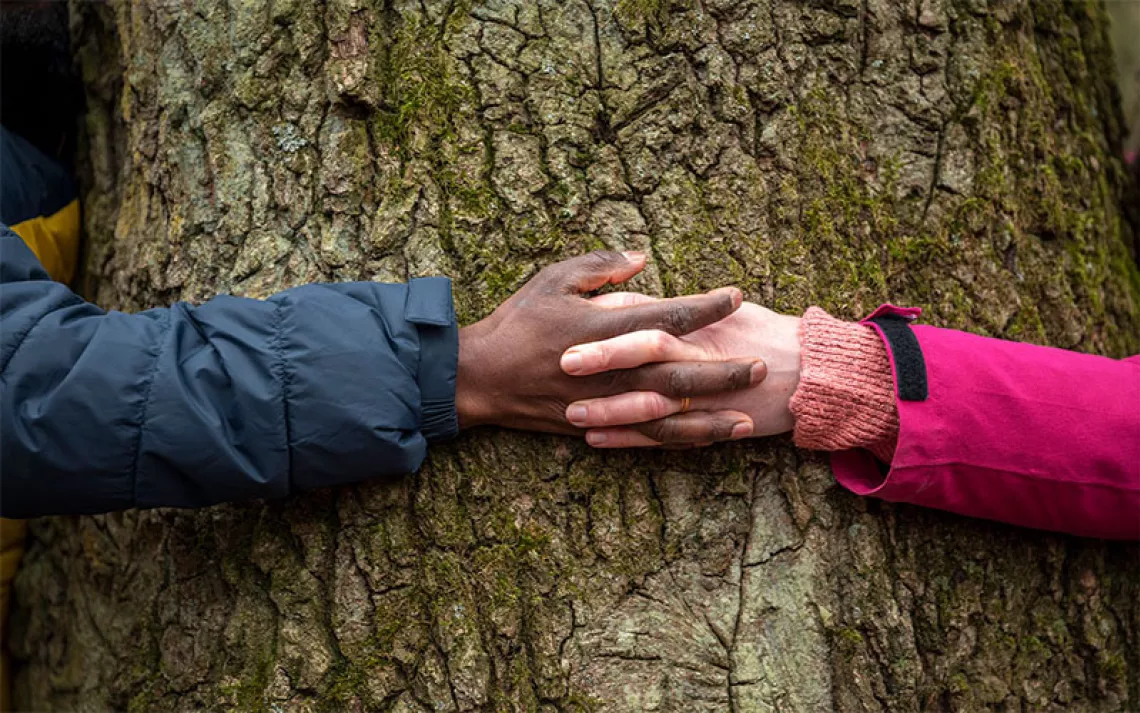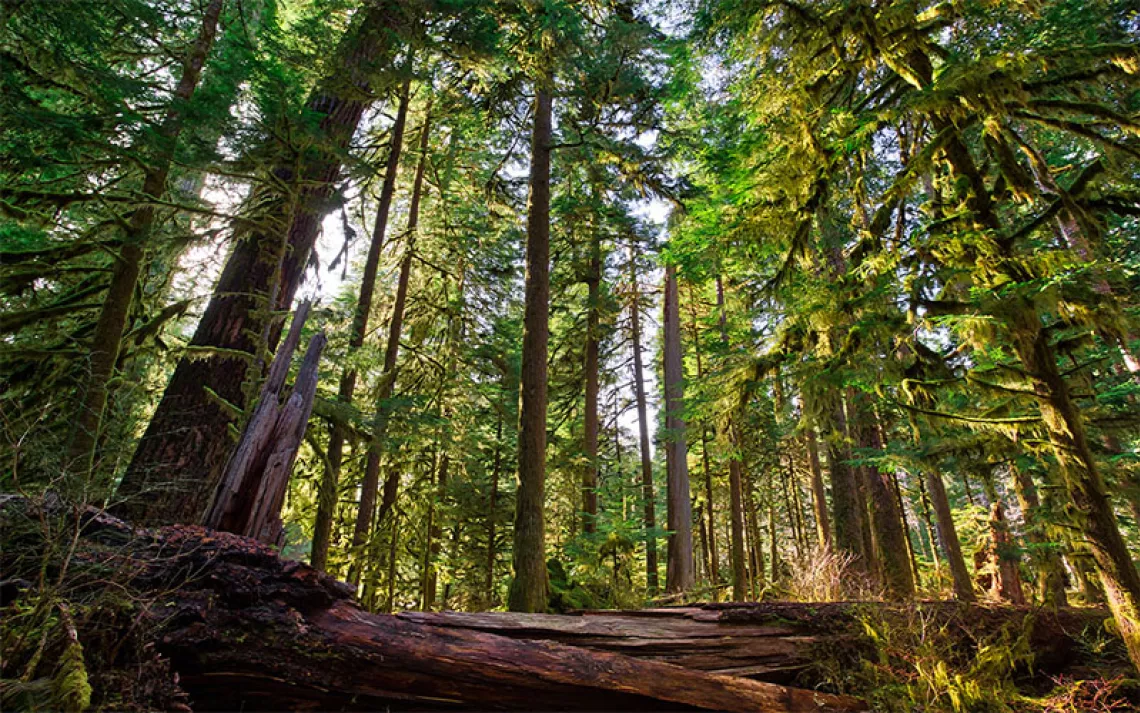Campaign Urges Agencies to Keep Big Trees Standing
Key forests are identified that are crucial to honoring old-growth executive order

Hand Lake and the Three Sisters volcanic peaks in Oregon's Willamette National Forest | Photo by Alandra Johnson
When Chandra LeGue first toured the Flat Country project, a logging and forest management project planned for the Willamette National Forest in Oregon, US Forest Service reps showed her a stream they planned to restore and a “plantation”—a deliberately planted, uniform stand of trees—that they planned to thin.
LeGue, who serves as senior conservation advocate for Oregon Wild, wandered away from the group and crossed a road into an older forest, where she found towering centuries-old Douglas firs, downed mossy logs, and a rich understory of conifer, shrubs, and ferns.
“When I asked what was planned for this forest, they told me something along the lines of regeneration harvest, or heavy thinning,” LeGue told Sierra, adding that these types of treatments are typically done to increase diversity for wildlife or for forest health. “But it was evident to me that this forest was already healthy and diverse,” she said.
First proposed in 2018, Flat Country included plans to harvest timber in about 2,000 acres of forests that are at least 80 years old. Some of these trees lie within the headwaters of the McKenzie River, which supplies drinking water to the cities of Springfield and Eugene.
The project has been broadly criticized; in 2021 citizens took to the trees, and last fall “kayaktivists” floated the McKenzie River in protest.
These trees are much more valuable left standing, says the Climate Forests campaign, a coalition of climate and conservation organizations. Mature and old-growth forests are climate champions; they not only store more carbon than younger forests, but they are also complex and biodiverse. Acknowledging the important role older forests play in fighting climate change, President Biden issued an executive order on Earth Day last year, directing agencies to inventory mature and old-growth forests on federal lands and develop policies to conserve them.
The Climate Forests campaign is pushing agencies to follow through on these tasks while highlighting projects on federal lands that run counter to the executive order. The campaign profiles nearly two dozen “worst-of-the-worst” projects in two reports, one published in November, one last July. The reports draw from on-the-ground feedback from local watchdog groups that keep tabs on timber sales on public lands around the country.
Two of the highlighted projects are in North Carolina’s Southern Appalachians, where virtually all forests were clearcut in the last 100 to 120 years. Precious little old-growth remains—about 5 percent in federal forests, even less on private lands, said Patrick Hunter, managing attorney for the Southern Environmental Law Center. There are also many “plantations,” which can benefit from management that helps make them more diverse.
“We’re OK with some logging if there’s an ecological benefit,” said Hunter. The projects the campaign has called out don’t make good ecological sense, he adds. One would log an area that is home to a rare population of green salamanders; the other targets a particularly high-quality forest. “It’s not old growth, but it has come back in exceptional form,” said Hunter. “There’s really no need to tinker with it.”
Four centuries of logging have also ravaged forests in New England, said Zach Porter, executive director for Vermont-based Standing Trees. “Our forests have been kept artificially young because we [still] log intensively across the region.” Most are between 75 and 125 years old; a tiny fraction of old-growth remains.
At the same time, the 5 percent of Northeast forests that have been left alone to recover store about 30 percent of the carbon, said Porter. “It just goes to show that when you give these ecosystems a chance, you can accumulate and store vast amounts of carbon.”
Two projects in Vermont’s Green National Forest encompass thousands of acres and require miles of new roads. One, designed to create young forest habitat, targets over 130 stands that are at least 100 years old.
In an email, Ethan Ready, public affairs officer for the Green Mountain and Finger Lakes National Forests, wrote that young forest habitat is especially important for pollinators and breeding songbirds. In addition, Ready wrote, creating half-acre or larger patches opens up stands that are currently dominated by diseased beech trees so that other, less shade tolerant tree species can move in.
Porter counters that, given how little old growth there is in New England, logging should happen in the youngest forests so that older forests can become old growth.
The Climate Forests campaign and other groups are pushing for a rule that protects all stands on federal lands that are 80 years and older. “Forests are beginning to mature at the age of 80,” explained Porter. “If you don't draw a clear line somewhere, we will never end up with old forests across the landscape.” The Biden administration, he added, has a critical window of opportunity to reprioritize federal public land in a way that elevates the ecological services and habitat benefits of older forests.
Protecting older forests from logging would help mitigate climate change while safeguarding critical wildlife habitat and drinking water sources, said Bev Law, an emeritus professor at Oregon State University. “Biodiversity and climate change are inextricably linked,” she said. “The two need to be treated together.”
Law has coauthored two reports—one that covers 11 western states, the other focused on Oregon—that lay out a framework for identifying “strategic forest reserves”—carbon-dense forests that are also rich in plant and animal diversity.
“We did a top-down synthesis that tells you, this is the biggest bang for your buck on where you can do these protections and succeed,” said Law.
The western states' study overlays biodiversity and carbon storage potential. The more detailed Oregon framework also considers resilience by factoring in the connections between different types of forests. Areas where the three metrics overlap are the highest priority for protection.
Both reports conclude that more forestland needs to be permanently protected, especially if we want to conserve 30 percent of US lands and waters by 2030.
Law’s framework and the administrative rule proposed by the Climate Forests campaign allow for “ecologically appropriate management,” especially to address the wildfire risk in the West. There is likely to be debate over what this exactly means. There’s more agreement on why forests are vulnerable—past logging and grazing history, fire exclusion, and warmer, dryer conditions that fuel intense wildfires—but less consensus on how to treat overgrown stands.
As a case in point, take the Ragged Ruby project in the Malheur National Forest in Eastern Oregon, which the Climate Forests campaign calls out on its website. The campaign criticizes the project for targeting old trees, but James Johnston, a research associate at Oregon State University, counters that the project is designed to save old growth—in particular, ancient ponderosa pines that have been dying of drought stress.
This forest, which should naturally burn every 10 to 15 years, is unnaturally dense, said Johnston. “The Forest Service’s solution—one that is supported by a diverse coalition—is to thin a lot of the younger trees in these stands.” Some of these grand fir trees may be larger than 21 inches in diameter and more than 80 years old, he said.
“But that’s the situation we find ourselves in in the year 2022 after 150 years of intensive modification of these landscapes,” said Johnson, “after decades of mismanagement—including overgrazing and overlogging—and after pumping carbon dioxide into the air.”
LeGue understands the need to protect the old giant pines, but said that since the Trump administration lifted the “21-inch rule,” which prohibited the harvest of trees larger than 21 inches in diameter—the Forest Service has been using restoration to justify logging of larger trees east of the Cascades. Such trees compose just 3 percent of forests but are responsible for 42 percent of the carbon storage.
Last July, the Forest Service, and BLM sought feedback to inform how the agencies should define and inventory mature and old-growth, as required by Biden’s executive order. And late last year, following a review, the Forest Service withdrew its decision on the Flat Country project in Oregon.
LeGue said the withdrawal was a “necessary step forward” to comply with the Biden administration's direction to preserve and recover mature and old-growth forests.
The Regional Forester will issue a revised plan for the project this spring, around the same time federal agencies are due to complete their inventory.
“We sincerely hope that the revised decision for Flat Country focuses on less outdated and controversial practices and drops logging in the mature forest stands that are so valuable for our climate, wildlife, and water,” said LeGue. “The fact is that these agencies are allowed—and at times have incentives—to log these old forests to meet timber targets or generate revenue. Until that direction changes, they will continue to do it.”
 The Magazine of The Sierra Club
The Magazine of The Sierra Club



